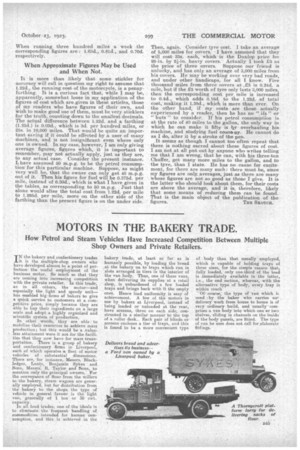MOTORS IN THE BAKERY TRADE.
Page 27

If you've noticed an error in this article please click here to report it so we can fix it.
How Petrol and Steam Vehicles Have Increased Competition Between Multiple Shop Owners and Private Retailers.
IN the bakery and confectionery trades It is the multiple-shop owners who have developed almost to a point of perfection the useful employment of. the business motor. So much so that they are coming into increasing competition with the private retailer. In this trade, as in all others, the motor—and especially the light and speedy unit— has enabled big •firms of bakers to give a quick service to customers at a com-. petitive price, simply because they are able to buy their ingredients on a large scale and adopt a highly organized and scientific system of production. In other words, they are able to mobilize their resources to achieve mass production; but this would be a .valueleis attainment were it not for the facilities that they now have for mass transportation. There is a group of bakery " and confectionery firms in Liverpool, each of which operates a fleet of motor vehicles of substantial dimensions. There are, for instance, Messrs. Blackledges, Lunts, Benjamin Sykes and Bons, Messrs'. R. Taylor and 'Sans, to mention only the principal owners.' For the conveyance of flour from the millers to the bakery, steam wagons are generally employed, but. for distribution from the bakery to the shops the type of vehicle in general favour is the light van, generally of 1 ton or 30 cwt.
capacity. • In all food trades, one of the ideals is to eliminate the frequent handling of commodities intended for human consumption, and this is "achieved in the bakery trade, at least so far as is humanly possible, by loading the bread at the bakery on to trays which run in slots arranged in tiers in the interior of the van body. Thus, one of these vans, when delivering its supplies at a retail shop, is unburdened of a few loaded trays and brings back with it the empty ones. Hence load uniformity is easy of achievement. A f(miv of the motors in use by bakers at Liverpool, instead of being loaded or unloaded at the rear, have screens, three on each side, constructed in a similar manner to the top of a roller desk., Each pair of blinds or screens encloses a tier of trays, and this is found to be a more convenient type of body than that usually employed, which is capable of holding trays of three sizes, for the simple reason that, fully loaded, only one-third of the load is immediately available in the latter, i.e., the end section, whereas, with the alternative type of body, every tray is within reach
-Of, course, the type of van which is used by the baker who carries out delivery work from house to house is of very ordinary build, and usually•eomprises a van body into which one or two shelves, sliding in channels on the inside of the body panels, are fitted. The type of van he uses does not call for elaborate fittings.






























